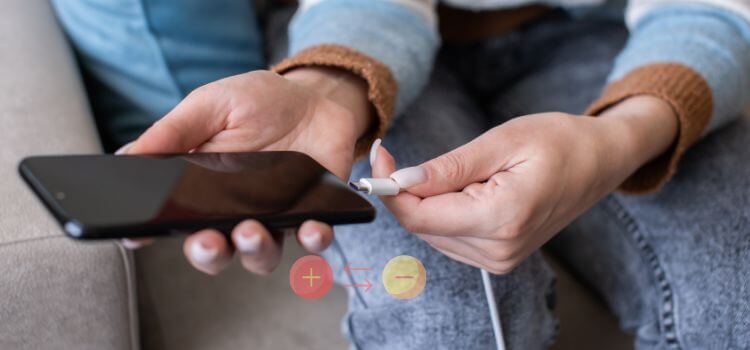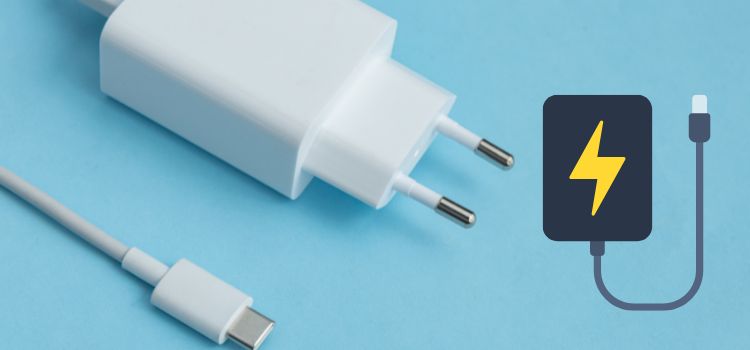As an Amazon Associate, I earn from qualifying purchases.
Distinguishing between positive and negative wires in phone chargers is crucial for safe and effective charging. This knowledge is helpful for repair purposes and essential for anyone interested in understanding how their devices function. This extensive book will cover the fundamentals of phone charger wiring, the importance of positive and negative terminals, and how to recognise them.
Basics of Phone Charger Wiring
Regardless of their make and model, phone chargers generally operate on the same fundamental principles of electrical circuits. They convert alternating current (AC) from your wall outlet into direct current (DC), suitable for charging your phone’s battery. This process involves several components, including the transformer, rectifier, and voltage regulator, all housed within the charger’s casing. However, the wires we are concerned with emerge from the charger and connect to the phone.
The Significance of Positive and Negative Wire in Phone Chargers
In any electrical circuit, including those in phone chargers, the positive and negative wires play critical roles. Current travels from the power supply to the gadget via the positive wire also called the hot wire. The negative wire, often called the ground or neutral wire, completes the circuit by returning current to the power source.
- Positive Wire (Hot Wire): This wire delivers power to your device. It is typically marked with red or another bright colour. Sometimes, it may also be identified by a solid line or a “+” symbol.
- Negative Wire (Ground Wire): This wire returns the current to the power source, completing the circuit. It is usually marked with black or another dark colour or might have a “-” symbol or a striped line.
Identifying the Positive and Negative Wires

Correctly identifying the positive and negative wires is vital for anyone looking to repair or understand their phone charger. Here are several methods to determine which wire is which:
1. Colour Coding
The most straightforward way to identify the wires is by their colour. Typically, phone charger cables adhere to a colour-coding system:
- Red: Positive (+)
- Black: Negative (-)
- White or Green: Ground (if applicable)
However, not all chargers follow this standard, especially older models or those from different manufacturers.
2. Symbols and Markings
Many chargers have symbols or markings on the cables or connectors:
- “+” or “Pos”: Indicates the positive wire.
- “-” or “Neg”: Indicates the negative wire.
3. Using a Multimeter for Wire is Positive and Negative on a Phone Charger
A multimeter can be a reliable tool for identifying the positive and negative wires:
- Set the Multimeter: Switch it to the DC voltage setting.
- Test the Wires: Place the red probe on one wire and the black probe on the other while the charger is plugged in.
- Read the Multimeter: A positive reading indicates the red probe is on the positive wire. A negative reading indicates the red probe is on the negative wire.
Importance of Correct Identification

Correctly identifying the positive and negative wires is essential for several reasons:
- Safety: Incorrect connections can cause short circuits, potentially damaging the phone’s charger or causing electrical fires.
- Device Protection: Proper wiring ensures that your device receives the correct voltage and current, essential for its longevity and performance.
- Troubleshooting: Knowing which wire helps diagnose and fix issues related to charging.
Practical Applications for Wire is Positive and Negative on a Phone Charger
Knowing the positive and negative wires is essential to repair a damaged charger or create a custom charging solution. Here are some practical applications:
A. Repairing a Damaged Charger
If your charger has a broken wire, you can fix it by:
- Cutting the damaged section: Use wire cutters to remove the broken part.
- Stripping the Insulation: Carefully strip the insulation from the ends of the remaining wire.
- Soldering the Wires: Both the positive and negative wires should be soldered to their corresponding terminals.
- Insulating the Connection: Use electrical tape or heat shrink tubing to insulate the connections.
B. Building a Custom Charger
For hobbyists and DIY enthusiasts, building a custom charger involves:
- Choosing the Right Components: Select a transformer, rectifier, and voltage regulator suitable for your device.
- Wiring the Components: Connect the components correctly, ensuring the positive wire from the transformer connects to the positive terminal of the rectifier and so on.
- Testing the Charger: Before using it with your device, use a multimeter to verify the output voltage and polarity.
Common Issues and Troubleshooting
Even with the correct identification of wires, issues can still arise. Here are some common problems and their solutions:
1. Charger Not Working
- Check Connections: Ensure all wires are correctly connected.
- Inspect for Damage: Seek out any obvious indications of damage to the connectors or cables.
- Test with a Multimeter: Verify that the charger outputs the correct voltage.
2. Device Not Charging Properly
- Check the Port: Ensure the charging port on the device is clean and free of debris.
- Use a Different Cable: The issue might be with the cable rather than the charger itself.
- Verify Voltage and Current: Ensure the charger provides your device’s correct voltage and current.
Final Thoughts for Wire is Positive and Negative on a Phone Charger
Understanding and identifying the positive and negative wires on a phone charger is essential for anyone interested in electronics. It ensures safe and effective charging, prevents potential device damage, and is crucial for repairs and custom projects. By following the guidelines in this article, you may operate with phone chargers with confidence and make sure your gadgets are safe and powered on. This information is helpful whether you work in electronics professionally or are a hobbyist.
FAQs on Identifying Positive and Negative Wire on a Phone Charger

How can I visually identify my phone charger’s positive and negative wires?
The positive and negative wires are often color-coded for easy identification. Typically, the positive wire is red, and the negative wire is black. The wires or connectors may have symbols like “+” for positive and “-” for negative. If colour-coding or symbols are absent, a multimeter is a reliable method to determine the polarity.
What tools do I need to identify the positive and negative wires without markings?
If there are no visible markings or colour codes, a multimeter is essential for identifying the positive and negative wires. You can ascertain the polarity based on the multimeter reading by adjusting it to the DC voltage setting and testing the cords while the charger is plugged in. A positive reading indicates the red probe is on the positive wire, and a negative reading indicates the red probe is on the negative wire.
Why is it important to correctly identify a phone charger’s positive and negative wires?
Correctly identifying the positive and negative wires is crucial for safety and functionality. Incorrect connections can lead to short circuits, potential damage to the charger or phone, and even electrical fires. Maintaining the correct polarity is essential to supply your gadget with the appropriate voltage and current, safeguarding its lifespan and functionality.
Can I repair a broken phone charger cable myself, and how?
You can repair a broken phone charger cable with the right tools and knowledge. Here’s a basic outline of the steps:
- Cut out the damaged section of the cable using wire cutters.
- Strip the insulation from the ends of the remaining wire.
- Determine which wires are positive and negative (use a multimeter if needed).
- Solder the wires back together, ensuring the positive.
Amazon and the Amazon logo are trademarks of Amazon.com, Inc, or its affiliates.